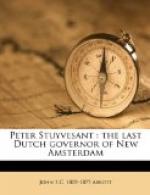The town wind-mill stood on a bluff within the present Battery. Pearl street at that time formed the river bank. Both Water street and South street have been reclaimed from the river. The city wall consisted of a row of palisades, with an embankment nine feet high. Upon the bastions of this rampart several cannon were mounted.
CHAPTER XVI.
THE OLDEN TIME.
Wealth and Rank of the
Ancient Families.—Their Vast Landed
Estates.—Distinctions
in Dress.—Veneration for the
Patroon.—Kip’s
Mansion.—Days of the Revolution.—Mr.
John
Adams’ Journal.—Negro
Slavery.—Consequences of the
System.—General
Panic.
Many of the families who came from the Old World to the Hudson when New Netherland was under the Dutch regime, brought with them the tokens of their former rank and affluence. Valuable paintings adorned their walls. Rich plate glittered upon their dining table. Obsequious servants, who had been accustomed in feudal Europe to regard their masters as almost beings of a superior order, still looked up to them in the same reverential service. The social distinctions of the old country very soon began to prevail in the thriving village of New York. The governor was fond of show and was fully aware of its influence upon the popular mind. His residence became the seat of quite a genteel little court.
“The country was parcelled out,” writes Rev. Bishop Kip,
“among great proprietors. We can trace them from the city of New Amsterdam to the northern part of the State. In what is now the thickly populated city were the lands of the Stuyvesants, originally the Bouwerie of the old governor. Next above were the grant to the Kip family, called Kip’s Bay, made in 1638. In the centre of the island was the possessions of the De Lanceys. Opposite, on Long Island, was the grant of the Laurence family. We cross over Harlaem river and reach Morrisania, given to the Morris family. Beyond this on the East river, was De Lancey’s farm, another grant to that powerful family; while on the Hudson to the west, was the lower Van Courtland manor, and the Phillipse manor. Above, at Peekskill, was the upper manor of the Van Courtlands. Then came the manor of Kipsburg, purchased by the Kip family from the Indians in 1636, and made a royal grant by governor Dongan two years afterwards.
“Still higher up was the Van Rensselaer manor, twenty-four miles by forty-eight; and above that the possession of the Schuylers. Farther west, on the Mohawk, were the broad lands of Sir William Johnson, created a baronet for his services in the old French and Indian wars, who lived in a rude magnificence at Johnson Hall.”
The very names of places in some cases show their history. Such for instance, is that of Yonkers. The word Younker, in the languages of northern




